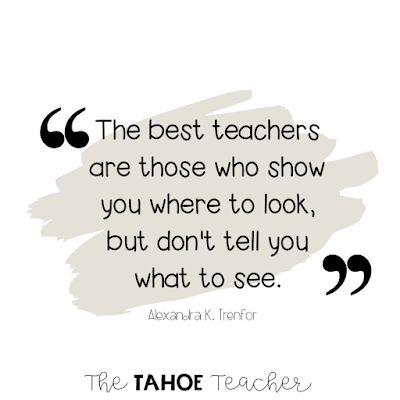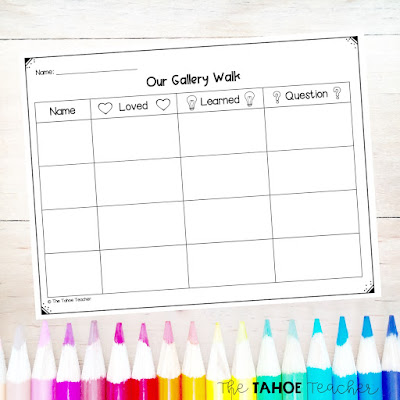Getting Started With Phenomenon and Inquiry-Based Learning
Hey, y'all! My inbox is full of questions about how to get started with inquiry and phenomenon-based learning units so I thought I'd take a moment to show you just how I map out our learning units. The task can seem daunting at first, but trust me, it's not as much work as you might think.
1. Choose an overall topic
Before I begin a unit, I choose a topic to focus on. In the spring semester, we decided to focus on forests since we live close to Lake Tahoe which is surrounded by a forest. It just made sense for us. If you live near a lake or ocean, you could do the same thing. You could also take a look a different types of communities, seasons, life cycles, or any other number of things. Choose something that makes sense for you, your class, and your grade level--something your students can relate to. For a list of topics we've used, check out my TPT store here.
2. Decide which standards/areas to focus on
Given that we did our forest unit in the spring, we needed to cover our standards about plants, habitats, and animals, so I broke up the unit into parts. Since there are three main types of forests--tropical, temperate, and boreal--I split our unit up based on each type of forest.
We looked at different habitats (1st set of standards) and the plants and animals we'd find there. We studied world maps and marked where we'd find each type of forest (2nd set of standards). We studied jobs people to do take care of conserve forests (3rd set of standards). We'd already talked about community helpers so the kids already knew about different types of jobs.
This unit led us straight into our plants unit in the spring where we learned about plant parts and life cycles (4th set of standards) . This gave students the schema they needed to find similarities in different types of plants and pollinators.
When choosing your standards to focus on, think about the things your students already have some knowledge of and what connections they can make to the new material. If you have a topic you want to explore and need some help identifying standards you could connect it to, don't be afraid to reach out and message me. I'm happy to help!
3. Gather resources
When you've figured out what direction you want to go in, it's time to gather some resources. Your school's library could have everything you need, but you might also have to go digital.
For several most of our units, I put together a digital resource (like an advanced hyperdoc) for students to use to find information. Remember, in inquiry and phenomenon-based learning, the teacher is leading the students to information not handing it directly to them.
YouTube videos, online learning games, ebooks like Get Epic! are great places to gather information for your students. For more information on how I compile information into a learning plan for my students, check out this blog post.
4. Get kids hooked
Before you give the kids all this information though, you need to hook them. We start with a QFT (Question Formulation Technique) session to get them interested and thinking about the topic. We write down students' questions, create a focus for our learning, and get them excited to know more. You're creating your essential questions together as a team.
I know what you're thinking. "What if the kids don't ask the questions I need them to ask?" Well, you can ALWAYS steer the conversation in the direction you need it to go. And if the kids just aren't on the right track, jump in and ask the question yourself. Lightbulbs will be going on all over the place.
5. Guide/coach/teach
Now that you're all ready, give the kids access to the resources you've gathered. If you're using printable texts, have a read-in day. If you're using digital texts or a mix of print and digital, give them access in Google Classroom™ or Seesaw or whatever you use.
For first grade, I only gave them access to a little bit of the information at a time. We spent a day or two on each type of forest, but the kids explored each of the links on their own and we came back together at the end of each day to talk about what they learned and fill in any gaps or answer any questions they might have had.
Depending on the topic, you may find yourself doing a whole-class direct teach, but it shouldn't be the focus of your unit. The idea is for students to construct their own knowledge with you as the facilitator.
6. Evaluate your direction
As you and your students move through the unit, you may find yourself making adjustments to your plan based on questions students have or ideas that come up. This is normal and should be celebrated because this means your students are thinking and doing the heavy lifting in their learning!
Let them lead you with their questions. Sure, you may have to make edits to your lesson plan or your learning plan, but your students will be engaged and you'll be hitting all kinds of standards within the context of students' interests. So make your adjustments, celebrate students' engagement, and keep going.
7. Repeat
Plan, question, facilitate/coach, adjust, repeat. Inquiry and Phenomenon based learning units are constantly being revised based on your students' feedback. Don't be afraid to make changes, repeat the process, and reevaluate.
8. Evaluate learning
Somehow, we have to evaluate student learning. Depending on the age of your students, you may be able to let them choose how they want to show their learning.
For the forest unit, my first graders had a choice of making a mini-book or a poster to illustrate their learning. They chose a type of forest to focus on and gave me as much information as they could remember about it.
Older students may build a model of their learning, create a presentation, write a mini-book or a paper, create artwork to represent their learning, do a Flipgrid or create a video about it, or anything else you and your students can dream up.
You can set the parameters ahead of time so students can be thinking about their final project, our you and class can build the evaluation criteria together. It's up to you.
Your first few inquiry or phenomenon-based learning units may be more structured than your later units. That's okay. As you get more comfortable with it and your students become more independent and inquisitive, your units of study will reflect that. Celebrate it!
Instead of turning work into me in these units, we show off our learning with a gallery walk. Students' projects are spread out around the room and the kids use this free gallery walk page to share their thoughts with their classmates and ask each other questions. The kids always learn something new by exploring what their classmates are teaching them.
I hope this helps you get a feel for how to setup a successful inquiry or phenomenon-based learning unit. These units are incredibly fun and rewarding for both you and your students. Whenever we finish a unit, I always have parents calling or messaging me about how impressed they are with their students' knowledge of the topic. It is definitely worth it to step outside your comfort zone and give it a try.
If you have any questions about setting up a unit or how to incorporate specific standards into a unit, please feel free to message me for help. And each of the units in my store has different examples and ideas to get you started.
I'm always adding new ideas, resources, tips, and freebies, so be sure to follow me on TPT so you don't miss anything. Have a wonderful week and I'll talk to you soon.
Stay cozy,









No comments
Post a Comment